Is Your Lighting System Up to Code?
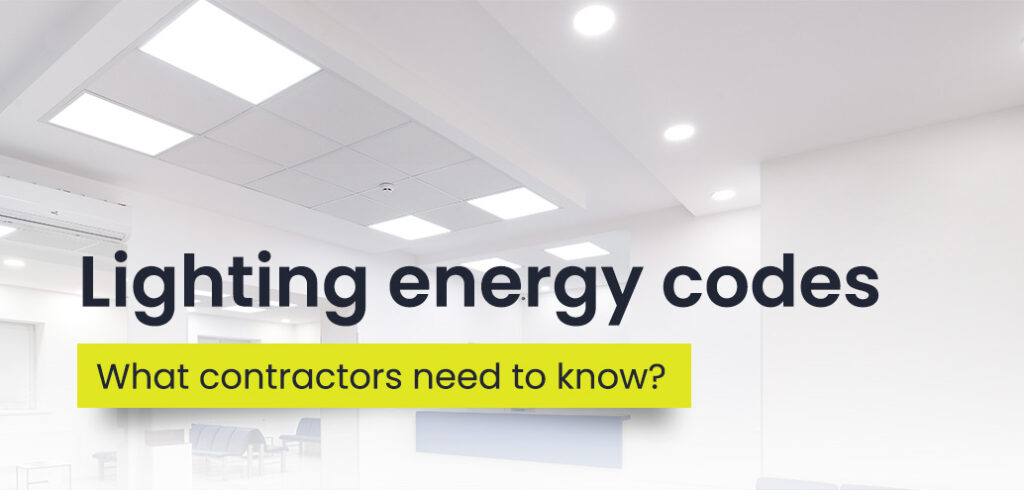
Energy codes! – sounds a bit scary or boring?
Well, it doesn’t have to be!
Because,
Energy code = Energy efficiency!
As a contractor, you are required to understand the lighting code requirements thoroughly to design a lighting system that well serves your client’s needs.
In this article, we are discussing three major commercial building energy codes and how they add value to your projects including renovations.
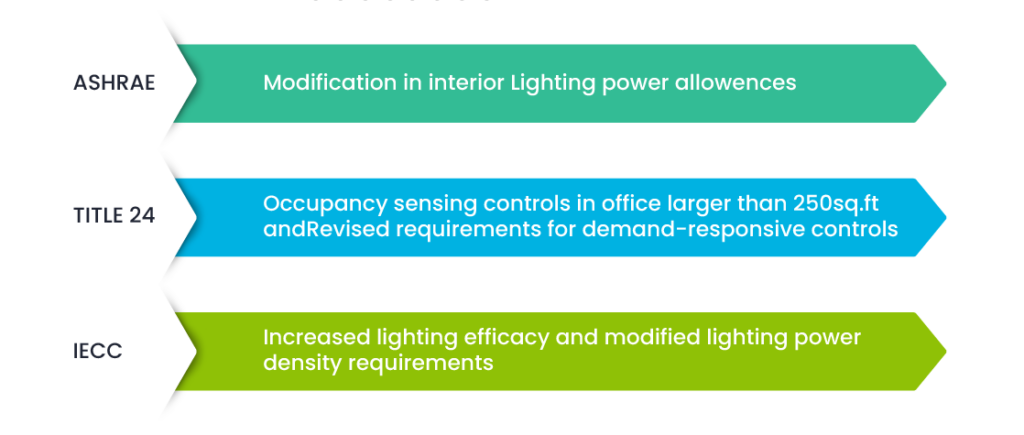
The latest in big three energy codes
ASHRAE 90.1, IECC, and Title 24 are crucial in reducing energy consumption and improving performance in today’s buildings.
ASHRAE 90.1
ASHRAE 90.1 provides the minimum mandatory requirements for energy-efficient buildings in the United States, except for low-rise residential buildings.
The 2019 revision contains significant changes in lighting control requirements
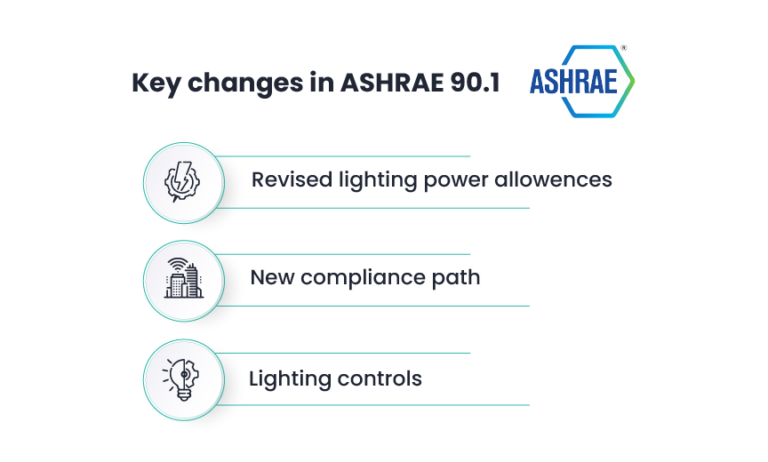
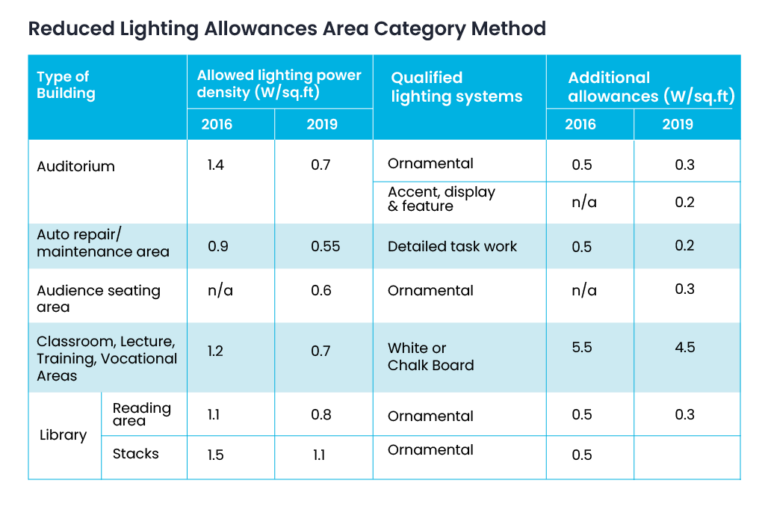
LPD is the total rated wattage of lighting fixtures used in a building or space per square foot
- Lighting power density requirement has been set lowest for parking garages; 0.18 W/sf and the highest for hospitals; 0.96 W/sf.
- Interior lighting power allowances increased for automotive, exercise center, gymnasium, library, parking garage, workshop.
New compliance path
The energy code offers new and a more simplified building area methods for contractors and designers who design or renovate buildings:
- Used for buildings with at least 80 percent of the floorspace used as an office, retail, or school building.
- Can be used for interior and exterior lighting for new buildings and tenant improvements under 25,000 sq.ft.
Lighting controls
Parking garage lighting
- Requires to automatically reduce lighting power by a minimum of 50% when the space is unoccupied for 10 minutes and a control zone is limited to a maximum of 3,600 sq.ft.
- Lighting control for covered vehicle entrances and exits must be reduced by at least 50 percent between sunset to sunrise.
- Automatically reduce lighting power in response to daylight within 20ft of perimeter wall openings.
Daylight responsive requirements
- Daylight responsive requirements were updated from continuous dimming or stepped control. When compared to stepped dimming, continuous dimming provides a smoother transition of light levels.
- Modified the side lighting requirements to clarify that the setback distance is a horizontal measurement and added natural objects as obstructions.
Automatic receptacle control
Plug load controls are required in all commercial buildings.
At least 50% of all receptacles in private offices, open office areas (including those installed in modular partitions) and computer classrooms must be controlled by an automatic control device like:
- An occupancy sensor that will shut off receptacles within 20-30 minutes of all individuals vacating a space
- A scheduled based / timer-based control device that turns receptacles off at specific programmed times
- A signal from another control system must turn off receptacles within 20 minutes of occupants leaving
Exceptions:
- Equipment designated for 24-hour continuous operation
- Space where an automatic shutoff would put occupants’ safety at risk
Title – 24
Title 24, the building energy codes for California, has significant changes in 2023, such as a mandatory implementation of occupant-sensing controls in all office spaces exceeding 250 square feet to enhance energy efficiency and optimize comfort for occupants and updated requirements for demand-responsive controls.
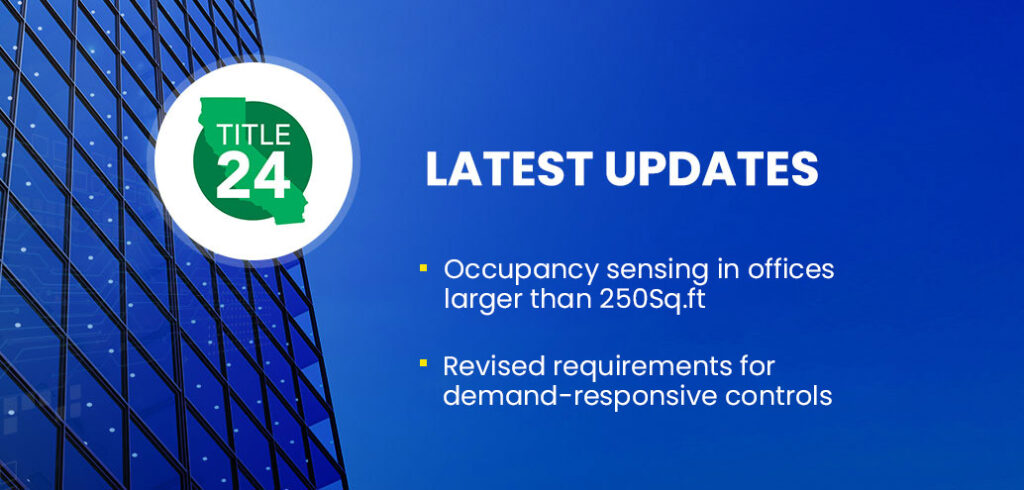
Occupancy sensing controls in office larger than 250sq.ft
All offices smaller than 250 square feet must be equipped with occupancy sensors that automatically turn off all lighting when the room is unoccupied.
As per latest Title 24 energy code update, occupancy sensors are mandatory for offices larger than 250 square feet. Furthermore, the maximum zone size for each sensor must be at most 600 square feet.
Revised requirements for demand-responsive controls
The demand response strategy induces lower electricity use during high consumption or when grid reliability is at risk based on a signal from the utility.Earlier, demand responsive controls are only required in building area above 10,000 ft2 . The new update requires demand responsive lighting controls for any building with an installed general lighting load totaling 4000W or more.
Title 24, the building energy codes for California, has significant changes in 2019, including a reduction in allowed interior lighting power density. Another important change is the inclusion of healthcare facilities as a newly regulated building type and many exceptions.
Title 24, Part 6 mandates the inclusion of plug load controls in demand response systems. The code requires that all automatically controlled outlets in the building can be turned off in response to signals from the utility company. The mandatory inclusion of plug load control in demand response is ensured, even though the owner is not obliged to impose the strategy.
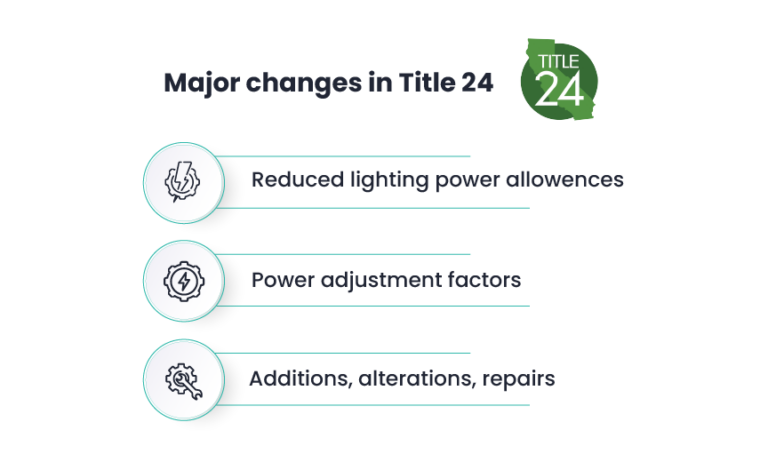
Reduced lighting power allowances
There are significant indoor lighting power density (LPD) reductions for all non-residential buildings and area types
On average, indoor lighting power densities have been reduced by 37 percent for the complete building method and 29 percent for the area category method
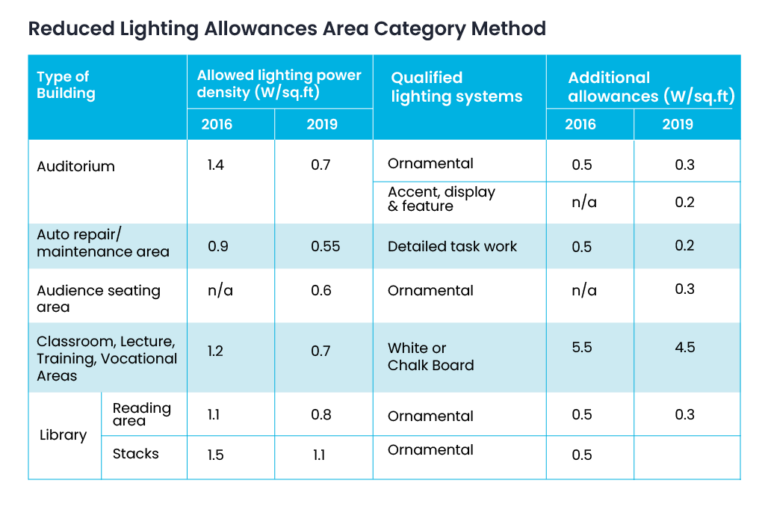
Power adjustment factors
Includes new PAFs to encourage the use of:
- Clerestory fenestration
- Horizontal slats
- Light shelves
Now projects gain 5 percent lighting power adjustment credit for implementing Clerestory fenestration or Horizontal slats and 10 percent lighting power adjustment credit for using Light shelves
Additions, alterations and repairs
The additions, alterations and repairs are now simpler!
Removing & reinstalling 10% or more of the existing luminaires in an enclosed space shall comply with specific requirements.
Daylighting and Controls
Daylight harvesting reduces energy consumption by taking advantage of natural light available in space. Under Title 24, buildings with skylit and sidelit zones must have daylighting controls in place. These controls automatically alter the power supplied into the fixture, depending on the time of day.
Exemptions:
- Glazing in room is <24 ft2
- Primary/Skylight lighting <120W
- Glazing with overhang above may be exempt
- Sidelight zones in retail merchandise/wholesale showrooms.
Want to know more about daylight harvesting? Check out our document here.
Plug load controls
Title 24 has brought significant changes in its 2019 version as follows.
- Requires both controlled and uncontrolled 120V receptacles in private and open offices, office kitchenettes, conference rooms, reception lobby and other spaces.
- There must be at least one controlled receptacle within 6 feet for each uncontrolled receptacle. Or duplex receptacles with one controlled and one uncontrolled shall be installed.
- There must be at least one controlled receptacle per workstation in open offices.
- The electric circuits feeding controlled receptacles must be automatically shut off within 30 minutes after the guest room has been vacated.
IECC
The International Energy Conservation Code (IECC) provides flexibility in adopting innovative techniques for energy-efficient buildings.
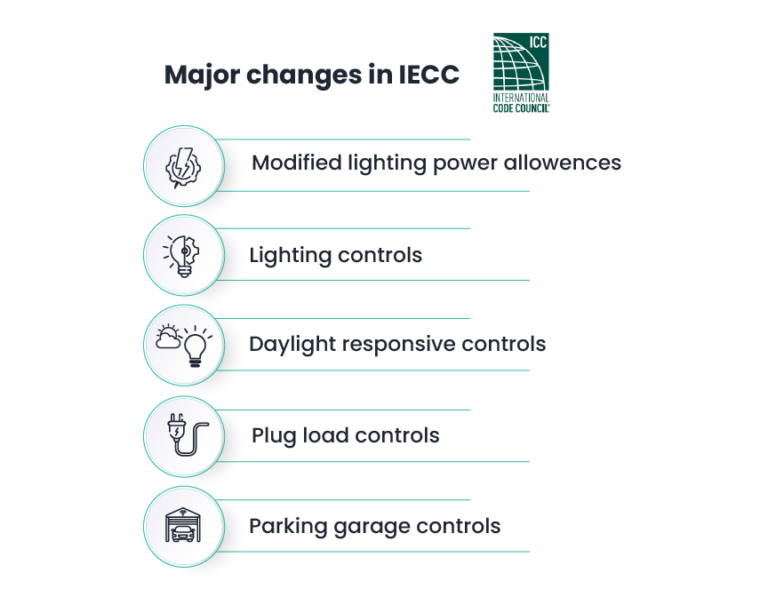
Lighting power allowances
Many of the building area method values decreased and a few building type LPD values increase
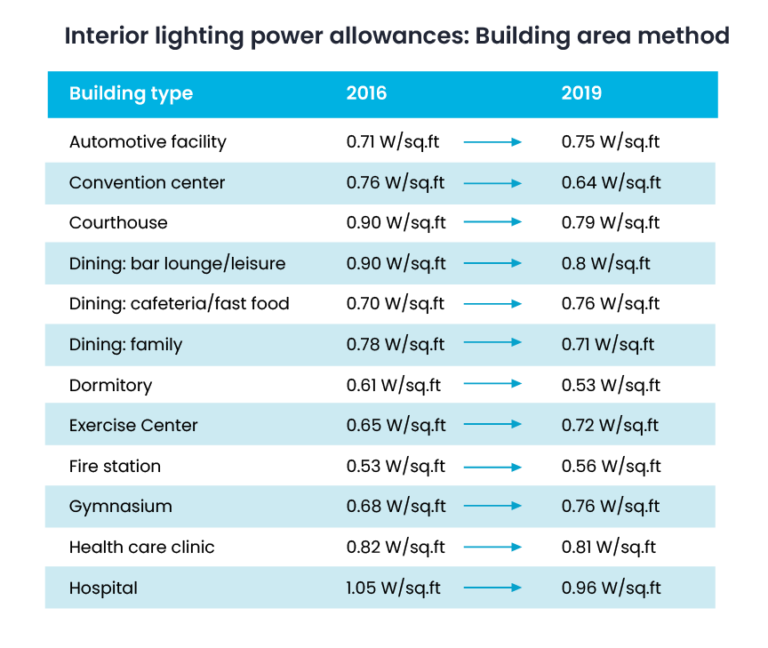
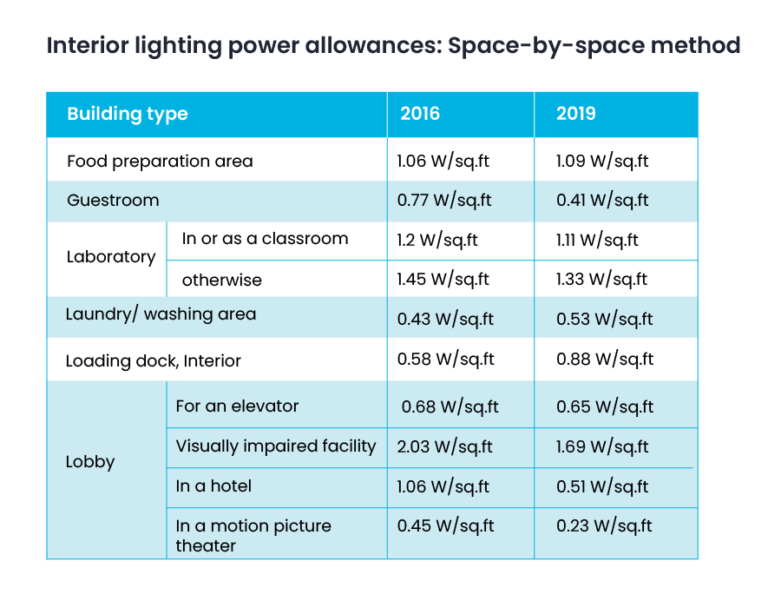
Lighting controls
IECC 2021 has several mandatory lighting control standards to automatically turn off or dim lighting when it is not being used.
This is achieved based on three inputs: occupancy, a time event, or ambient light level.
Occupancy sensing
- The code now mandates corridors to have occupancy sensors that lower lighting power by at least 50% within 20 minutes if the space is empty.
- Sensors must turn OFF all general lighting within 20 minutes of occupants leaving the space, or a time-switch control must provide this on a scheduled basis.
- Additionally, lighting in each warehouse aisle must be controlled separately
Light reduction controls
A manual switch is required in locations without occupancy sensors and daylight responsive controls without requiring a 50% reduction in light.
Dimming options are made clearer in IECC 2021. It now includes shutting down all luminaires or all luminaire rows to 30–70% and continually dimming from full light to less than 20% power.
Parking garage controls
In parking garages, lighting controls are required. The code contains a new section that requires occupancy sensors or time switches to control lighting in parking garage.
The lighting power needs to be reduced with an occupancy sensor and a maximum control zone of 3,600 square feet. Entrance and exit lighting should be reduced by at least 50% during sunset and sunrise.
Plug load controls
The updated version of IECC also has receptacle control requirements.
- At least half of all permanently installed 15A and 20A receptacles must be controlled in specific applications such as enclosed offices, workstations, and classrooms. Additionally, at least 25% of branch circuit feeders installed for modular furniture not shown on the plans must be controlled.
- The control function may be split-controlled receptacles with the top controlled or separate controlled receptacles within a foot of each uncontrolled receptacle.
- The receptacles may be controlled via an occupancy sensor, scheduled basis using a time-switch control function or signal from another system.
Exterior lighting
Exterior lighting must be turned off when there is sufficient sunlight. IECC 2021 requires lowering dusk-to-dawn lighting power to 50% 50% of the full level after hours. An occupancy sensor must dim certain outdoor parking lot luminaires when not in use.
Know the code!
Energy codes don’t have to be a headache; in fact, they offer wide energy savings opportunities and high return on investment! Getting acquainted with the lighting energy code and understanding how it applies to your building projects will let you do the job perfectly while avoiding multiple callbacks and reviews.
Want to build a code-compliant commercial lighting ecosystem? We can help!